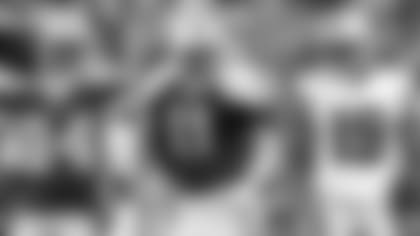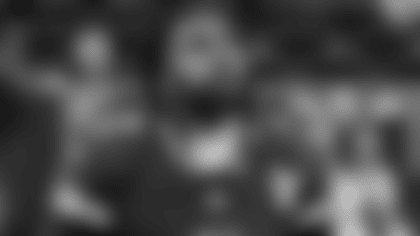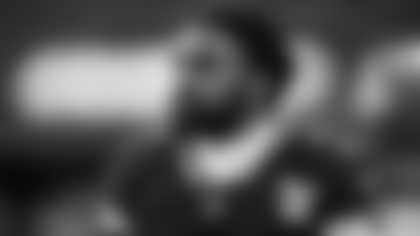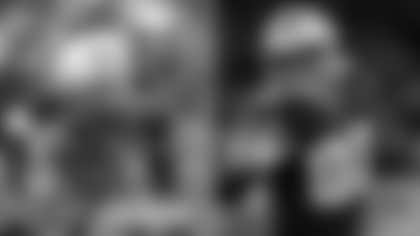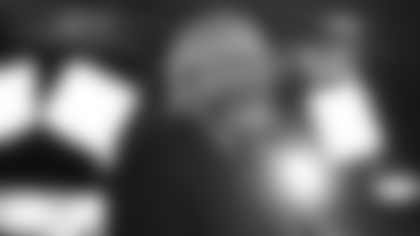This is rare territory for your Dallas Cowboys. While 2019 marks the 59th year that the team will take part in the NFL Draft, this will be only the eighth time that the Cowboys enter the annual festivities with no pick in the first round.
When that happens, the job of restocking the ranks becomes just that much tougher, as there is a reason that players are selected within the first 32 picks. They, of course, are generally considered the best bet to become impact players in the league.
So obviously without that No. 1 choice, the Cowboys will have their work cut out for them in Nashville, Tenn., come April 25-27. They're now forced to dig deeper to perhaps find that needle in the haystack who can quickly step in and contribute.
The Cowboys reached this dilemma by trading their 2019 first-round pick to the Oakland Raiders on Oct. 22 of last season in exchange for Amari Cooper. And the move paid immediate dividends as the wideout jumpstarted the offense, posting 725 receiving yards and six touchdown catches in his nine games with Dallas while helping the team to a 7-2 record, an NFC East title and a victory over the Seattle Seahawks in the wild-card round of the playoffs.
But while everyone agrees the trade was a successful one, the time has come, as the saying goes, for the other shoe to drop.
So what might we expect? What happened during the previous seven occasions when the Dallas brass walked into its war room not owning a first rounder? What led to that situation, and more importantly, was the ensuing draft a success or failure?
Let's take a look back in history to see just what transpired. In every instance, the deals were made in hopes of making the Cowboys better. However, whether the moves actually worked or not is an entirely different matter.
1961
History: While the Cowboys began play in 1960, they weren't afforded the luxury of participating in that year's NFL Draft. The event was actually held on Nov. 30, 1959, two months before the city was officially granted a franchise on Jan. 28.
Then on June 22, 1960, wanting a veteran presence to guide their upstart expansion group, the leadership trio of Tex Schramm, Gil Brandt and Tom Landry traded away their first- and sixth-round choices in the 1961 draft to the Washington Redskins for the rights to quarterback Eddie LeBaron. Meaning when the team's first official draft came around on Dec. 27, the Cowboys no longer had what would have been the second overall pick.
Although it's hard to believe now, back in those days, there was no time limit on making selections. So when the Cleveland Browns, which had already used the 10th overall pick, let it be known they were now willing to trade the 13th choice, off Schramm went to negotiate a deal, hoping to outbid the Philadelphia Eagles, who were also interested.
It took two hours, the entire draft basically coming to a standstill while the two sides worked out the particulars.
In the end, the Cowboys traded away starting offensive tackle Paul Dickson and their first-round pick in 1962 to get the man they had coveted all along: Bob Lilly out of nearby TCU. He would go on to become one of the greatest players in club history. Earning the nickname, "Mr. Cowboy," he was the first Dallas player inducted into the Pro Football Hall of Fame as well as the team's Ring of Honor.
Verdict: Aside from Lilly, the 1961 draft didn't produce much else. Only five of the Cowboys' 17 picks in that draft – remember, there were 20 rounds – made the roster with none of the other four playing more than two seasons with the team.
So does the unrivaled success of one man make the entirety of the draft a success or failure? In hindsight, the Cowboys were more than happy with the results.
1962
History: Of course, with Dallas having made the deal for Lilly the previous year, the team now found itself in the same situation when the 1962 draft rolled around on Dec.4, 1961, this time losing the fourth overall pick. But unlike the previous time, the Cowboys stayed pat, not going on the clock until the 18th choice came on the board, which was then part of the second round for the much smaller league.
Of the 15 picks the team made that year, six managed to find a spot on the roster, but only one truly enjoyed any kind of success: defensive end George Andrie, who was grabbed with the second of two sixth-round picks. He took the field for 11 years with Dallas, and over a five-year stretch from 1965-69, earned five consecutive Pro Bowl invites and a First Team All-Pro recognition in the final season of that run.
Verdict: It was slim pickings after Andrie. Defensive tackle Guy Reese, who grew up in Dallas and went to SMU, led the rest of the field, earning NFL All-Rookie honors in his first season. He was a two-year starter for the Cowboys before being traded to the Baltimore Colts in 1963. But that second-round pick? Quarterback Sonny Gibbs never played a down for Dallas.
1967
History: Five years would pass before the Cowboys would again enter a draft without a first-round pick, but this time it came due to a penalty of sorts.
Two seasons earlier, All-Big 8 offensive tackle Ralph Neely was selected in the second round of both the NFL and AFL drafts, the Colts and Houston Oilers each claiming him as theirs. But Neely had no interest in moving to the East Coast, so signed a deal with the Houston club.
That was before the Cowboys acquired Neely's rights on Aug. 29, 1965. Now wanting to be in Dallas, he basically told the Oilers, no thanks, and returned their check. Houston, however, wanted its man and lawsuits soon followed. A year later, after the two leagues merged, the Cowboys agreed to send their first, second and two fifth-round picks in the 1967 draft to the Oilers as compensation.
Without its first two selections, Dallas seemingly had its hands tied, and overall the draft that year was understandably disappointing. Of the 14 players selected, just four made the team.
But there was one true diamond in the rough. In the seventh round, the Cowboys took a defensive end out of tiny Fort Valley State, weren't pleased with his play along the defensive front, tried him at tight end and then finally, in 1969, moved him to offensive tackle. There, Rayfield Wright would become a Hall of Famer.
Verdict: While probably not quite as good in whole as the Lilly draft of 1961, Wright at least provided some greatness in a 1967 sea of mediocracy. And Neely proved to be worth it, as he played 13 seasons with Dallas, earning three All-Pro honors and two trips to the Pro Bowl. He was also named to the Pro Football Hall of Fame's All-1960s Team.
1980
History: The Cowboys were content to hold on to their top draft pick over the next decade, until a pair of player moves in 1979 forced their hand. Coming off two straight trips to the Super Bowl, Dallas entered that season without two of its key pieces along the defensive line: Jethro Pugh retired after a 14-year career, all spent with the Cowboys, with Ed "Too Tall" Jones then shocking the team by deciding to give up football to try his hand at boxing.
With the window for another championship still open, Schramm and company decided to fill the void by acquiring three-time Pro Bowl defensive tackle John Dutton, who was tied up in a contract dispute with Baltimore. The deal was completed on Oct. 9, Dallas giving up both its first- and second-round choices in the 1980 draft.
Now a 12-round affair, the Cowboys still had 11 picks with six eventually making the team's roster. The best of the bunch, though, was likely Kurt Petersen, a defensive lineman who was chosen in the fourth round, promptly converted to guard, and then went on to play 88 games with 66 starts over six seasons.
Quarterback Gary Hogeboom, taken in the fifth round, and running Timmy Newsome, grabbed in the sixth, both proved to be capable backups and even held starting roles later in their careers. But neither really came close to reaching star status.
Verdict: In the end, Dutton played nine years with the Cowboys and was a solid, if unspectacular contributor. But was he worth the high price? The downfall of the Cowboys in the 1980s has often been linked to a poorer effort in drafting, and the lack of their top two draft picks in this year's festivities certainly played a part.
Add in the fact that Jones returned from his pugilistic stint the very next year and second-guessing the move seems an easy endeavor.
2000
History: Although the Cowboys became known as wheeler-and-dealers in the early years of the Jerry Jones era , and indeed they weren't shy about making trades, the team always managed to enter the draft with at least one first-round pick.
That trend came to an end in 2000, though. And much like what happened in 1980, it was a case of the team perhaps reaching to fill a hole while the window for a championship was still open.
Already, the beginning of the end for the Triplets had started, wide receiver Michael Irvin having gone down with a career-ending injury during the 1999 season. Needing a new scoring threat to join quarterback Troy Aikman and running back Emmitt Smith, the Cowboys swung a deal with Seattle on Feb. 12, 2000. Dallas sent the Seahawks its first-round picks in both the 2000 and 2001 drafts in exchange for speedy wideout Joey Galloway.
With the team having also traded away its third-round selection, the Cowboys now had only five picks in the seven-round draft. Four of those were then used to nab defensive players.
In reality, only one proved to be worthwhile, as Mario Edwards played in 74 games for Dallas over four seasons with 47 starts. Somewhat surprisingly, he was actually the third cornerback taken by the team in that draft. Neither second-rounder Dwayne Goodrich or fourth-round pick Kareem Larrimore ever really panned out.
Verdict: In retrospect, this went down as one of the worst trades in Cowboys history, namely because Galloway suffered a knee injury in his first game with the team and missed the rest of the season. He eventually played four more years in Dallas but with Aikman retiring after that 2000 campaign, Galloway never quite lived up to the lofty expectations.
Rubbing salt in the wounds, with the Cowboys' first-round pick Seattle chose running back Shaun Alexander, who topped 1,000 yards five times in his career on his way to becoming the Seahawks' career rushing leader.
2001
History: Rinse and repeat. Reeling from the injury to Galloway in his inaugural season in Dallas, the Cowboys had no choice but to enter the 2001 draft without a first rounder. But they then traded down in the second round, sending what would have been the 37th overall selection to Indianapolis in exchange for the 52nd pick. That was in turn sent to the Miami Dolphins for the 56th choice as Dallas moved down again.
But thanks to a trade with New Orleans, the Cowboys jumped back up and finally went on the clock in the 53rd slot. There, Dallas surprised many by grabbing quarterback Quincy Carter. That was followed by selecting safety Tony Dixon with that 56th pick.
By 2003, Carter had Dallas back in the playoffs, but after one more injury-plagued year, he was out of the league. Dixon also lasted only four seasons, but primarily served as a defensive backup and special teamer.
Verdict: The Cowboys actually had nine picks in 2001, but aside from Carter's one flash-in-the-pan year, none brought much to the team other than depth. It was a second consecutive disappointing draft effort.
2009
History: Once again, the Cowboys made an ill-fated attempt to fill a void in the pursuit of a championship. The 2007 season had seen the team finish with an impressive 13-3 record, only to be upset at home in the second round by the eventual Super Bowl champion New York Giants.
Needing another target for quarterback Tony Romo midway through the 2008 season, and perhaps already knowing this would be the last year mercurial wideout Terrell Owens would be with the team, the Cowboys acquired receiver Roy Williams from the Lions on Oct. 14, 2008. Also receiving a seventh-round pick in the 2009 draft, Dallas sent Detroit its first, third and sixth rounders in that same 2009 draft.
But despite not having a first-round selection, the Cowboys then traded their second-round pick on draft day, meaning they didn't go on the clock until the third round, 69th overall. Thanks to a number of additional trades, Dallas actually wound up with 12 picks in 2009, but only six eventually made the team. And really just one, linebacker Victor Butler, became a regular contributor, playing four seasons and appearing in 63 games, primarily as a special teamer.
Tight end John Phillips, tabbed in the sixth round, had 20 starts and 48 games played in three seasons with the Cowboys and was still in the NFL as of last year. But with Jason Witten ahead of him on the depth chart, his impact in Dallas was minimal.
Verdict: Anytime the annual selection process is described as a "special teams draft," the likelihood is the results won't be good. And sure enough, this turned out to be the frontrunner for poorest draft in Cowboys history.
And if the Galloway trade wasn't the worst in team annals, this Williams deal certainly was, as he turned out to be a bust. Five games into the 2009 season he was surpassed by Miles Austin as the team's top receiving threat and then only started nine of his 15 games in 2010, his last in Dallas.
None of these seven drafts without a first-round pick turned out to be particularly great overall, although individual greatness was uncovered in some years. Which means the Cowboys undoubtedly face a risky proposition as they head into the 2019 NFL Draft.
In reality, a verdict on the success or failure of both the trade and the team's selection won't be decided until several years down the road. But as of right now, one thing is for sure: Fan can certainly be happy with who the Cowboys are claiming as their No. 1 pick this year … Amari Cooper.



